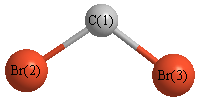Jump to
S2C1
Energy calculated at CCD/6-31G**
| | hartrees |
|---|
| Energy at 0K | -5177.887269 |
| Energy at 298.15K | -5177.892278 |
| HF Energy | -5177.522827 |
| Nuclear repulsion energy | 325.012796 |
The energy at 298.15K was derived from the energy at 0K
and an integrated heat capacity that used the calculated vibrational frequencies.
Geometric Data calculated at CCD/6-31G**
Point Group is C2v
Cartesians (Å)
| Atom |
x (Å) |
y (Å) |
z (Å) |
|---|
| C1 |
0.000 |
0.000 |
1.014 |
| Br2 |
0.000 |
1.555 |
-0.087 |
| Br3 |
0.000 |
-1.555 |
-0.087 |
Atom - Atom Distances (Å)
| |
C1 |
Br2 |
Br3 |
| C1 | | 1.9057 | 1.9057 |
Br2 | 1.9057 | | 3.1108 | Br3 | 1.9057 | 3.1108 | |
 More geometry information
More geometry information
Calculated Bond Angles
| atom1 |
atom2 |
atom3 |
angle |
|
atom1 |
atom2 |
atom3 |
angle |
| Br2 |
C1 |
Br3 |
109.413 |
|
Electronic energy levels
Charges, Dipole, Quadrupole and Polarizability
Jump to
S1C1
Energy calculated at CCD/6-31G**
| | hartrees |
|---|
| Energy at 0K | -5177.868764 |
| Energy at 298.15K | -5177.873793 |
| HF Energy | -5177.539338 |
| Nuclear repulsion energy | 315.413786 |
The energy at 298.15K was derived from the energy at 0K
and an integrated heat capacity that used the calculated vibrational frequencies.
Geometric Data calculated at CCD/6-31G**
Point Group is C2v
Cartesians (Å)
| Atom |
x (Å) |
y (Å) |
z (Å) |
|---|
| C1 |
0.000 |
0.000 |
0.756 |
| Br2 |
0.000 |
1.659 |
-0.065 |
| Br3 |
0.000 |
-1.659 |
-0.065 |
Atom - Atom Distances (Å)
| |
C1 |
Br2 |
Br3 |
| C1 | | 1.8510 | 1.8510 |
Br2 | 1.8510 | | 3.3185 | Br3 | 1.8510 | 3.3185 | |
 More geometry information
More geometry information
Electronic energy levels
Charges, Dipole, Quadrupole and Polarizability
